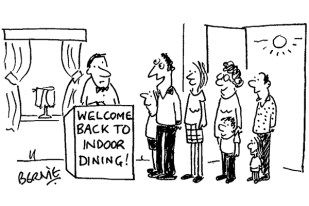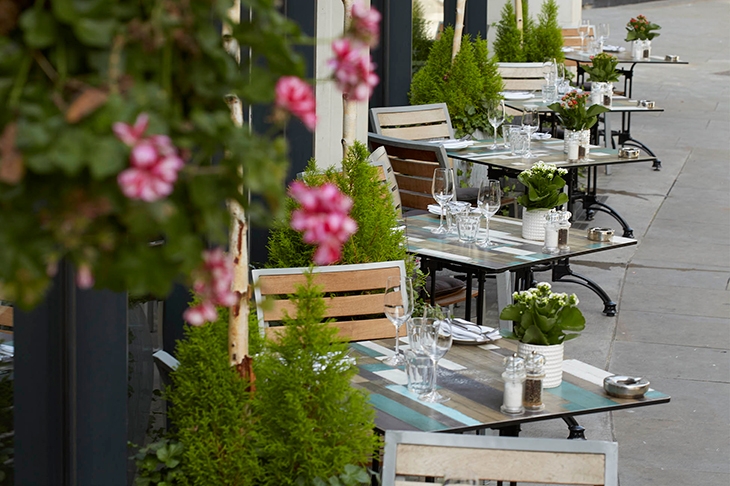You cannot have cars and dining tables in the same dreamscape: it doesn’t work, unless you think carbon monoxide is a herb, or are wearing full Hazmat, like some teachers. London is in much denial about its air pollution; in the East End child asthmatics are choking. But we must embrace it for a few days more; others have lost more in pandemic than an attachment to the convention that if we dine outside it should be in a flower-filled garden. Perhaps there are enchanted restaurant gardens in London, but I have never found one. I conclude that, outside fiction or aristocracy, they do not exist.
Instead, we have modish kerbside dining. I have always mocked people who bought flats with balconies on London’s roads and sometimes are mad enough to sit on them and look happy, but a curio — a mistake — becomes a luxury with ease. It’s a question of supply and demand: you know that better than I. Just now, the only restaurant tables available are out of doors; and so, just by existing, they become desirable.

But are they? It’s funny to watch people eating under brollies with water in their socks and invoking the Blitz spirit — increasingly I think people don’t really understand the Blitz spirit, which was about bombs and not salad. Restaurant marketing is as skilful as ever — nothing destroys advertising, and it never will — and I am glad. They will need it as they rise from the calamity. But I am increasingly convinced that outdoor dining is unpleasant, especially if it has pretensions, and expensive restaurants have to have pretensions because they are not selling food, but self-worth, self-deception and love.
Take 28-50, a restaurant on Mary-lebone Lane. I like this lane, just north of Wigmore Street; it follows an irregular path and includes a 167-year-old hardware shop — David Penton & Son — which pre-dates Selfridges by half a century. Do buy a broom there. 28-50 is a ‘wine workshop and kitchen’ though this description makes it sound more exhausting than it is. I like this kind of restaurant, though it is not for me: it is transient, dramatic and necessary. It is all windows; there are bubble-pink chairs below upturned wine glasses; every surface is polished. The food exists to accompany the wine — it has a notable wine list — and not the other way round. All of this is superb if you are under 30, or an alcoholic of any age, or indoors. But on the lane itself, where we sit on slender chairs and at a slender table (the transience is explicit), it is dismal. I wonder at the peculiar greyness of the road — every grey is here — and at what chime in late capitalism we began to bicker over tables in the street.
I think people don’t really understand the Blitz spirit, which was about bombs and not salad
As consolation, we order almost everything, and it taunts us because it is made to be eaten in meadows: a vast plate of cheese and charcuterie; artichoke tempura; truffle arancini; burrata; ham hock terrine; fries. In no restaurant I have yet encountered can you shout: I want a meadow. None of this skilful, pretty food can detract from the fact that we are, at this point in history, sitting in a street between two of the most polluted roads in a great city, trying to have what we had before, failing, and so taking the remnants. It is mad, expensive camping; here, it is for the congenitally shy. I love it for its hope, and despise it for its greed.
I would rather eat a bacon sandwich and a Curly Wurly on a haystack; perhaps the flight to the countryside indicates that now everyone would. But this, too, is transient and that is apt for Marylebone, a space between two roads; the end is coming.
28-50, 15-17 Marylebone Lane, London, W1U 2NE, tel: 020 7486 7922.







Comments